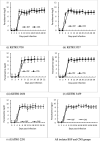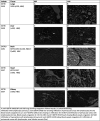The pathogenicity of blood stream and central nervous system forms of Trypanosoma brucei rhodesiense trypanosomes in laboratory mice: a comparative study
- PMID: 38162635
- PMCID: PMC10755267
- DOI: 10.12688/f1000research.75518.2
The pathogenicity of blood stream and central nervous system forms of Trypanosoma brucei rhodesiense trypanosomes in laboratory mice: a comparative study
Abstract
Background: Human African trypanosomiasis (HAT) develops in two stages namely early stage when trypanosomes are found in the blood and late stage when trypanosomes are found in the central nervous system (CNS). The two environments are different with CNS environment reported as being hostile to the trypanosomes than the blood environment. The clinical symptoms manifested by the disease in the two environments are different. Information on whether blood stream are pathologically different from CNS trypanosomes is lacking. This study undertook to compare the inter-isolate pathological differences caused by bloodstream forms (BSF) and central nervous system (CNS) of five Trypanosoma brucei rhodesiense ( Tbr) isolates in Swiss white mice. Methods: Donor mice infected with each of the five isolates were euthanized at 21 days post infection (DPI) for recovery of BSF trypanosomes in heart blood and CNS trypanosomes in brain supernatants. Groups of Swiss white mice (n = 10) were then infected with BSF or CNS forms of each isolate and monitored for parasitaemia, packed cell volume (PCV), body weight, survivorship, trypanosome length, gross and histopathology characteristics. Results: Amplification of SRA gene prior to trypanosome morphology and pathogenicity studies confirmed all isolates as T. b. rhodesiense. At 21 DPI, CNS trypanosomes were predominantly long slender (LS) while BSF were a mixture of short stumpy and intermediate forms. The density of BSF trypanosomes was on average 2-3 log-scales greater than that of CNS trypanosomes with isolate KETRI 2656 having the highest CNS trypanosome density. Conclusions: The pathogenicity study revealed clear differences in the virulence/pathogenicity of the five (5) isolates but no distinct and consistent differences between CNS and BSF forms of the same isolate. We also identified KETRI 2656 as a suitable isolate for acute menigo- encephalitic studies.
Keywords: BSF; CNS; Morphology; Trypanosoma; pathogenicity.; rhodesiense.
Copyright: © 2023 Ndungu K et al.
Conflict of interest statement
No competing interests were disclosed.
Figures







References
-
- Greenwood B, Whittle H: The pathogenesis of sleeping sickness. Trans. R. Soc. Trop. Med. Hyg. 1980;74(6):716–725. - PubMed
Publication types
MeSH terms
LinkOut - more resources
Full Text Sources

